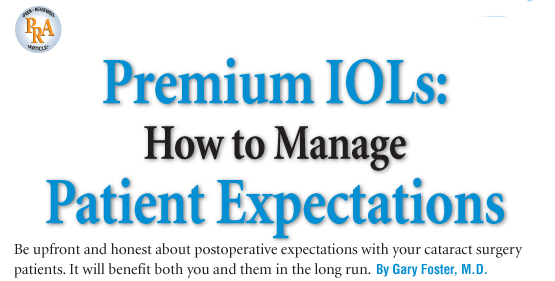
Although cataracts cause a multitude of difficulties for our patients, modern cataract surgery with quality postoperative comanagement can restore visual function.
Many patients have friends who underwent standard cataract correction, so they may have an idea of what to anticipate after the surgery. However, most patients do not have friends who have had surgery with a presbyopia-correcting IOL, so they probably do not know what to expect until they are properly educated by their O.D. This article provides an overview of how to honestly and realistically manage your cataract patients expectations.
Patient Wants and Needs
Postoperatively, some of our cataract surgery patients have become accustomed to living with the refractive disabilities associated with the standard cataract procedure; but, that does not mean they want to be accustomed to them. Most patients would prefer to be less dependent on spectacles after cataract surgery.
This is exactly what custom cataract correction with premium intraocular lenses can do for many patients. Premium IOLs offer added features or benefits compared to standard lenses.
For example, astigmatism- and presbyopia-correcting lenses, in some instances, can improve a patients visual acuity to a higher level than it was before cataracts ever developed.
The market rewards doctors who help patients get what they want and many patients want their vision enhanced. Optometrists who embrace laser vision correction and help their patients get what they want heighten patient satisfaction levels and generate greater practice revenues.
The same principle applies to comanaging premium IOL cataract surgery patients. O.D.s who become experts in premium IOL comanagement will experience high rates of patient satisfaction. Also, your practice will grow through referrals from these contented patients.
Refractive IOL expertise will require a concerted and ongoing effort by optometrists as the technologies and techniques are advanced. Patients will appreciate your assistance when you help them choose the best lens for their lifestyle and needs.
Premium IOLs
Patients who choose a premium IOL may not know what to expect, but given the premium out-of-pocket costs to the patient, they may expect a corresponding premium experience and outcome. This raises the bar on the quality of preoperative measurements, surgical skill, perioperative management and required doctor-to-patient time. Patients rely on your expertise, so time invested in quality preoperative counseling is time well spent.
Managing patient expectations should not be an arduous task. Simply educate your patients about what IOLs will and will not do for them. This allows them to make a positive, informed decision.
Even premium IOLs are not perfect. So, O.D.s must inform and counsel cataract surgery patients to ensure that their expectations are in line with what a particular IOL can deliver. You will spend years following these patients, and you want them to be pleased with their visual outcome, the level of care you provide and the advice you offer.
Be Honest and Realistic
It may help to inform your patients that no man-made lens will be as precise as their natural lenses once were. Patients will appreciate your honesty and will be more likely to accept certain compromises necessary to correct their near focus acuity.
Realize that patients generally consider issues described before surgery as expectations and those discussed after surgery as complications. Ultimately, it is better to understate the benefits and overstate the side effects of IOLs. Patients will not be frustrated with you for being too blunt before surgery.
Some practitioners quote patients the odds of not requiring glasses after surgery. Unfortunately, some patients misinterpret this statistic to mean that they will not need to wear glassesnot that they may not need to wear glasses. So, to be safe, many practitioners now tell their premium IOL patients that they will need glasses for some activities after surgery. This counsel sets a level of expectation that you can consistently meet and will frequently exceed.
Appropriate cataract care requires meticulous preoperative measurements with state-of-the-art testing equipment and modern IOL calculation formulas. But, even with these considerations, most patients arrive close tonot exactly attheir targeted refractive outcome.
It is wise to warn patients of this possibility preoperatively. For example, you might say: Patients usually have reasonable distance vision without glasses with this lens, but not perfect vision. You will most likely be able to watch TV, but you may need to put glasses on to read the scores or the stock ticker at the bottom of the screen. There is a chance that you may not achieve this level of functional vision after the initial surgery, and you may even require additional procedures to achieve your targeted goal. Again, it is best to set the bar low and err on the side of caution.
The Right IOL
Choosing the right IOL happens when the patient is educated on the lens options and the doctor understands the patients visual needs and desires. This allows an open discussion on which lens will provide the best fit for the patients lifestyle.
Be sure to carefully discuss the strengths and weaknesses of the specific lens that will be employed.
For example, patients who receive accommodating IOLs, such as the crystalens (Bausch & Lomb), are often happier if I emphasize that they will most likely need glasses for extended reading. If they do not end up needing the readers, I have exceeded their expectations. If they do need glasses, then they are already prepared. Similarly, if I implant the ReZoom Multifocal Lens (AMO), I tell the patient that he or she may need reading glasses. If I plan to implant the ReSTOR Aspheric (Alcon), I tell the patient that he or she may need glasses to read a computer screen.
Tell your multifocal IOL patients that they likely will experience some nighttime haloes. Often, these haloes are mild, and most patients quickly adapt. The halo effect appears to be more pronounced with the ReZoom Multifocal than with the ReSTOR Aspheric.1,2 However, even patients who experience moderate to severe haloes usually adapt and become happy with the lenses over time (figure 1).
Recent advances in IOL technology have made it easier to manage patient expectations. According to Michael Breen, O.D., vice president of Clinical Outcomes at Baush & Lomb, the crystalens 5.0 model has proven to be more stable in the capsular bag and less prone to late deformations by capsular contraction than the previous 4.5 model.3
Also, postoperative management of patients with the AcrySof ReSTOR has become much easier since the release of the ReSTOR Aspheric because correcting for spherical aberration has improved the optical quality of the image. This is illustrated in the Air Force bar graph, which shows a distance image through four different IOLs (figure 2). Patients often adjust more readily to their multifocal vision and are satisfied at an earlier stage with the ReSTOR Aspheric than with the original ReSTOR.
1,2. Detailed negatives of what an oncoming car headlight would look like to a patient wearing one of four leading IOLs (left). Right, this Air Force bar graph shows perceived distance vision clarity through the same four IOLs. Photos courtesy of Jim Schwiegerling, Ph.D.

Meeting Expectations
Patients with keratoconus, macular degeneration or an epiretinal membrane cannot achieve superior distance vision or reading visionno matter which IOL they choose. Usually, it is wise to discourage such patients from a presbyopia-correcting lens because you simply cannot meet their expectations. But, some patients who are not good candidates for presbyopia-correcting IOLs may still benefit from a premium IOL that reduces astigmatism, such as the AcrySof Toric (Alcon) or the STAAR Toric IOL (STAAR Surgical Company).
Helping patients have a good experience with astigmatism- or presbyopia-correcting IOLs is similar to helping patients have a good experience with their first pair of progressive addition lenses. In my practice, the success rate for a first time fit of standard progressive lenses is approximately 90%. However, this means that about 10% of patients wish they would have purchased either lined bifocals or separate readers instead.
If progressive lens patients are unhappy with their vision, but have dry eye, do not blame the lenses. Instead, first correct the dry eye, and then assess the lens. Similarly, if the patients experience -0.75D of residual refractive error or astigmatism, do not condemn progressive lenses in general. But, expect these patients to be dissatisfied until the refractive error is corrected.
It is a similar situation with premium IOL management. In the FDA trial for the AcrySof ReSTOR in 2005, 94% of patients were happy with their postoperative visual outcome, and would again choose this IOL if they had to undergo the surgery a second time.4
Still, as positive as this figure is, it means that some patients will not initially be pleased with their presbyopia-correcting IOLs. Most patients will become satisfied after careful postoperative management.
If premium IOL patients have -0.75D of residual refractive error or astigmatism and are not 20/happy, do not give up on refractive IOLs in general. Expect that they will not be happy until you correct their refractive error with glasses or contacts, or refer them for limbal relaxing incisions, laser vision correction or piggyback IOLs.
If patients have dry eye, the surface must be stabilized prior to surgery. Patients with posterior capsular opacity will often need a capsulotomy before they are pleased. A very small percentage of patients will not be pleased even after these steps are taken, and may require an IOL exchange.
Helping patients broaden their depth of focus, decrease their astigmatism and enhance their eyesight has been a source of great joy for our practice. We now have the opportunity to make our patients vision even better than it was before cataracts developed if we use premium IOLs and surgical comanagement techniques both wisely and judiciously. Careful attention to managing patients expectations is essential to for overall success.
Dr. Foster is in private practice in
1. Chang DF. Prospective functional and clinical comparison of bilateral ReZoom and ReSTOR intraocular lenses in patients 70 years or younger. J Cataract Refract Surg 2008 Jun;34(6):934-41.
2. Choi J, Schwiegerling J. Optical performance measurement and night driving simulation of ReSTOR, ReZoom, and Tecnis multifocal intraocular lenses in a model eye. J Refract Surg 2008 Mar;24(3):218-22.
3. Breen M. Personal communication with author. Jun 2008.
4.

